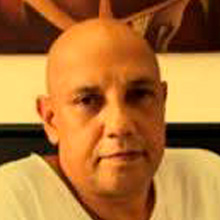Un humorista superhiperultramegapremiado
Sobre el humor gráfico cubano, puedo decir que de niño siempre disfrutaba de las caricaturas que publicaban en las últimas páginas de la revista Bohemia y fui creciendo con "Zig Zag", "El Pitirre", "Palante", "El sable", "La Chicharra", "Dedeté" y "Melaíto". Y vi caricaturas de Landaluze, Horacio, Prohías, Frémez, Guerrero, Muñoz Bachs, Sergio, Abela, Raúl de la Nuez, René de la Nuez, Adigio, Fornés, Chago, Fresquito Fresquet, Val, Pitín, Betan, Miriam, Évora Tamayo, Cardi, Delga, Wilson, Ñico, José Luis, Betanzos, Felo, Pecruz, Mitjans, Rosen, Alexis, Lillo, Pime, Milan, Lloró, Chevo, De Armas, Alba, Perfecto Romero, Blanquito, Arístides, Behemaras, Posada, Chamaco, Ardión, Virgilio, Urra, Jerez, Carlucho, Manuel, Ajubel, Juan Padrón, Tomy, Torres, Hernán Hernández, Tonel, René, Pedro Méndez, Douglas Nelson, Martirena, Roland, Panchito, Polo, Linares, Delga, Felix, Janier, Lázaro, Laz, Boligán, Simanca, Carrillo, Lauzán, Tamayo, Abela (nieto), Acebo, Agramonte, Castillo, Avilés, Emilio, Grant, Guille, Lumat, Migue, O. Tejedor, Peroga, Quiala, Quintana, Romero Pino, Testón, Tomaso, Urguellés, Ramsés, Adán, Omar Santana, Osval, Lacoste, Roger, Garrincha, Villamil, Falco, Bermúdez, Toledo, Jánler, Zardolla, Orlandito, Joseph y otros colegas que seguro se me olvidan, ya que estoy apelando a la memoria y a la investigación de mi entrevistado. Por lo tanto, pido mil disculpas por alguna omisión. Pero esta lista no la hice por gusto. Fue para darme la oportunidad de rendirles un homenaje a todos los humoristas gráficos cubanos (estén en esta lista o no), por ofrecerme tanto disfrute con sus obras y por ayudarme con ellas a mi formación. Gracias mil.
Pues de lo mejor de lo mejor del humor gráfico cubano, seleccioné a uno que no nombré anteriormente a propósito. Tengo el honor y el placer (y no son palabras protocolares en este caso) de desarrollar este diáloco con el requetegalardonado caricaturista, ilustrador, pintor y psiquiatra cubano, mi buen amigo Arístides Esteban Hernández Guerrero, conocido mundialmente como “Ares”, porque así firma sus obras.
PP: ¿Qué diferencia el Ares de los inicios al de ahora? No me refiero a la experiencia adquirida, a la madurez; sino a si tuviste cambios de conceptos en el humor, tanto en forma como en contenidos.
ARES: Muchas cosas me diferencian de aquel Ares de los inicios y eso lo considero una fortuna, si continuara haciendo lo mismo que concebía hace treinta y cinco años estaría liquidado. Cuando comencé, y tras algunos tanteos, creo que hallé bastante rápido una manera personal dentro del dibujo de humor. Ese comienzo está marcado por un chiste centrado en el gag que evadió el texto y por una figuración bastante limpia, algo ingenua y con personajes que yo definiría como bonachones que evolucionaron en un par de años hacia aquellos gordos que marcaron mi estética.
Como resultado de un proceso habitual que ha estado ocurriendo en mí durante años mi humor mudó de lo cándido a lo ácido y la figuración de mis personajes se movió a lo grotesco como una consecuencia inevitable de la transformación en los contenidos, que considero más pendientes del tiempo y el mundo que me rodea.
Otra arista de las diferencias entre esos Ares ha sido la disolución de la frontera que delimitaba mi humor gráfico, lo cual se evidencia en la diversificación de las expresiones artísticas en las que me muevo y de las técnicas que manejo en ellas. Si al inicio solo realizaba caricaturas con tinta sobre cartulina, ahora, sin abandonar jamás esta técnica, utilizo también la acuarela, el acrílico sobre cartulina, lienzo o madera, la serigrafía, las técnicas digitales y realizo lo mismo ilustraciones para libros, carteles, pintura, murales, esculturas, instalaciones….
Pero me parece que a pesar de todos esos cambios la matriz conceptual de toda mi obra ya se hizo evidente desde mis primeros trabajos. Ahora tengo menos pelo y más barriga, parezco otro pero sigo siendo el mismo.
PP: Además de ser un creador de humor gráfico tan galardona como señalé con justicia en el título de este diáloco, sé que te interesa la historia del género en Cuba y hasta le dedicas tiempo al rescate y promoción de nuevos valores. Y encima inauguras exposiciones y haces de jurado por el ancho mundo. ¿Cómo haces para cumplir con todo eso, sin dejar de ser un ser familiar y social?
ARES: No tengo horarios ni espacio especifico para trabajar. Algunos colegas míos comienzan a crear a las ocho de la mañana y la familia no les molesta hasta que terminan, te aseguro que no es mi caso. Hay días que no tengo un minuto para hacer obras, en otras ocasiones desplego jornadas de creación de dieciséis o más horas diarias sin parar durante uno o varios meses. Dice también mi esposa que mis insomnios son los más productivos que ella conoce.
Cuando no puedo concentrarme en dibujar o pintar me pongo a escribir y organizar los textos e imágenes que se transforman luego en mis libros. Mientras estoy en reuniones dibujo sin parar y hasta utilizo esas imágenes en exposiciones, cuando no estoy creando sigo viviendo y en mi vida está el origen de mis ideas.
Estoy acostumbrado a crear contra el tiempo y bajo cualquier circunstancia. Comencé a publicar dibujos cuando tenía veinte años y era estudiante de tercer año de medicina, recuerda que durante quince años simultaneé mi creación con los estudios en la universidad, mi servicio social en las montañas de Guantánamo, la dirección de un hospital rural, partos, consultas, guardias médicas, estudios de mi especialización en psiquiatría, investigaciones médicas, mi trabajo como psiquiatra en el Hospital Calixto García y en el Combinado del Este (el centro penitenciario más grande de Cuba).
Mi trabajo, mi vida social y personal son solo partes de un algo único, que soy yo. Están imbricadas por todos los lados y eso es algo que sufro y disfruto. Mi familia es generadora de muchas de mis creaciones, disfruto además con ella inauguraciones, conciertos y más actividades que son de nuestra vida social y mi vida creativa. Mis amigos, aficionados, estudiantes y otras muchas personas circulan por casa en tráfico interminable, las fiestas y actividades conjuntas son espacio de diversión pero también para nuevos proyectos. Y de lo que dices de los jóvenes valores, yo solo ayudo y promuevo a los que creo con talento, esos a la vez se convierten en parte de mi grupo de amistades por lo cual es cierto que yo siempre estoy entregando, pero también siempre estoy recibiendo.
PP: En varios países de América Latina se dice: "Mi país es un pueblo de humoristas", "En mi país, tú mueves una piedra y sale un humorista", etc. ¿En Cuba se dice lo mismo?
ARES: No solo en Latinoamérica, en todos los países dicen lo mismo, los cubanos no nos quedamos atrás. Pero es una mentira, los cubanos somos hijos del choteo, nos burlamos de los demás pero nos molesta que se burlen de nosotros, eso no es tener sentido del humor.
PP: ¿Es verdad la acuñada frase: "Es más fácil hacer llorar que hacer reír”?
ARES: Sí, no tengo dudas. Tú con solo enviarme esta entrevista ya lo lograste y para hacerme reír en el Teatro Carlos Marx tuviste que pasarte meses ensayando
PP: Ahora sobre ti: tanto en tu línea, tu estilo, como en tus contenidos, ¿crees que tienes influencia definida, clara, de colegas cubanos vivos o históricos?
ARES: Sí, tengo influencia de mucha gente lo que no sé si es clara o definida. Nada nace de la nada y todos cuando comenzamos buscamos cánones que nos sirven para enrumbar el camino, ya sea en la estructuración de la personalidad como en la formación como artistas que es una parte fundamental de esa individualidad nuestra.
Siendo muchacho y antes de publicar algún dibujo copiaba miméticamente en libretas de escuela caricaturas publicadas en Palante, Dedeté, Bohemia… así como las historietas del personaje “Naoh” que dibujaba Roberto Alfonso. También me inventaba ingenuos remedos del comic americano, a lo Dick Tracy y dibujaba personajes de las películas de samuráis, cowboys y de guerras que veía con mi padre; creaba personajes, hacia caricaturas de colegas y profesores. Recuerdo también haber visitado en Bellas Artes una pequeña muestra de Picasso y no olvido que ese contacto sacudió mi espíritu.
Cuando comencé en serio con el humor gráfico lo que más me interesó de lo que existía en Cuba en ese momento era la estética del Dedeté. Ese primer camino bebió de Carlucho, de Manuel, de Tomy, de Ajubel… Algunos colegas y críticos consideraron, por mis personajes regordetes, que tenía influencias del pintor colombiano Botero. En ese caso específico te comento que no es así, tenía veinte años no conocía su obra en ese momento pues por ser autodidacta era un desconocedor absoluto de muchas expresiones y artistas del arte cubano y universal.
Luego, la participación en eventos internacionales me hizo descubrir otras maneras y sentí inclinación por algunas líneas de humor gráfico que se reproducían en los catálogos. Me resulta bastante difícil enumerar todos los nombres que me han marcado de algún modo, son muchos, pero puedo decirte que mis influencias no se han restringido al dibujo de humor sino que abarcan también otras áreas de las artes visuales.
PP: Los humoristas gráficos hacen caricatura personal, o editorial o costumbrista, etc., porque su intención es hacer reír o sonreír, aunque algunos –como tú-, también unen esa intención con la de pensar, pero sin dejar de provocarlo con el humor por muy conceptual que sea la idea, porque de lo contrario no serían “humoristas gráficos”. ¿Estás de acuerdo con eso?
ARES: Estoy de acuerdo contigo. Yo digo que mi humor es esencialmente serio, conceptual tal vez… pero eso es una definición general. Tengo muchas obras que pueden causar mucha risa e incluso carcajadas. El humor está en todas las cosas que hago, pero está primariamente dentro de mí, yo no puedo evadir hacer comentarios o asociaciones que generan la carcajada en cualquier espacio, eso me define como persona y ahí está la base de toda la obra que hago.
A la hora de realizar mi trabajo como humorista gráfico trabajo con la sorpresa y utilizo la imagen como mediadora. Yo pienso que lo conceptual está dado porque busco en toda la información visual y de contenidos que circula dentro de mí la manera de realizar asociaciones en las que los puntos de origen de los elementos que las conforman sean distantes y paradójicos, los vínculos cercanos son más comunes, se les ocurren a cualquiera y creo que en ese proceso de tener información, buscarla y hallarle el engranaje en tu conciencia es en donde está el quid de la cosa.
Ni siquiera sé si respondí tu pregunta, aunque sé que es inevitable en este intercambio con otro humorista no terminar teorizando sobre el tema, ahora… para mí siempre es más fácil decir que cosa NO es humor que definir porque otra cosa SI lo es.
PP: Pregunta de moda: ¿hay límites en el humor?
ARES: ¿Te colocas en la situación del editor de una publicación…? ¿Ya? Entonces… ¿Haces o aceptas publicar dibujos ensalzando la superioridad de una raza sobre otra? ¿Haces o aceptas publicar chistes a favor de la pedofilia?
Resulta, según veo, que ningún dibujante acepta tener límites y eso ciertamente en la posición de espectador me causa risa. Los dibujantes que juegan en el tablero con las fichas blancas hacen muchos chistes de las negras, los que están del lado del rey negro, hacen bromas de las fichas blancas, los que hacen chistes de los dos se consideran grises pero jamás los verás meterse con los dueños del tablero. Todos convivimos con alguna forma de censura, sea política, religiosa, económica, ideológica… Los límites para el humor existen, como para todo, mi hermano, pero los que me interesan a mí son los que están imbricados con la ética del dibujante.
Me viene a la mente la filmografía de Carlos Saura, sin los límites que impuso el Franquismo sus películas hubieran sido otras. Muchas de las mejores obras de arte que he visto han surgido en ese debate entre límites, censuras, símbolos y la capacidad del creador de decirlo y abordarlo todo con maestría
También creo que es imposible ser imparcial pero si es necesario ser honesto con uno mismo y por encima de cualquier límite hacer una obra que responda a tus convicciones artísticas y éticas, eso es lo que he intentado hacer yo en estos treinta y cinco años de carrera.
Hay un detalle al que quiero referirme que no se si está dentro del límite de tu pregunta pero se asocia a ella: Los caricaturistas nos damos más importancia de la que tenemos, muchos creemos que con un dibujo o con muchos podemos cambiar el orden de las cosas y eso es mentira.
El humor señala cosas, incide en las opiniones pero no llega a tener ese poder que le adjudicamos. Si así fuera te aseguro que el mundo hace mucho tiempo sería un mejor lugar. Esa fuerza que pretendemos está dispersa en otros segmentos de la sociedad contemporánea, somos un equipo con un cuerpo pequeño y un Ego muy grande.
PP: ¿Te sientes feliz y realizado con tu carrera en el humor, con tantísimos premios? ¿Qué sientes saber que eres uno de los más grandes humoristas gráficos de Cuba de todos los tiempos? (Te conozco y sé que no eres soberbio ni autosuficiente, pero tampoco seas muy modesto ahora, por favor).
ARES: Soy un hombre que trabaja en algo que le fascina y que además vive de ese trabajo. Eso es algo que me genera mucho bienestar y que siempre le he trasmitido a mis hijas: descubran qué es lo que les gusta e intenten hacer todo lo que este a su alcance para trabajar en ello, porque cuando eso sucede no importa lo que pase serás una persona feliz.
¿Realizado en plenitud? Eso sería pedir demasiado, yo siempre vivo con un espíritu de inconformidad en lo que respecta a mi obra. Esto me genera una habitual zozobra, me hace ser un tipo muy crítico conmigo mismo, con lo que hago y me obliga a estar buscando siempre algo nuevo.
PP: ¿Alguna anécdota relacionada con nuestra profesión?
ARES: Estaba en México, en la frontera con Belice y fui a la zona franca a comprar barato (cubano al fin). Había olvidado en Chetumal mi pasaporte al cambiarme de camisa y al pasar de nuevo por el puesto fronterizo me detuvieron por “Inmigrante ilegal”. Las guardias eran dos mujeres mexicanas mal humoradas y ahí quedé varado en un espacio pequeño. Luego de un buen tiempo allí llegó un hombre llamado Manuel, mexicano también, al parecer de mayor rango. Se paró a mi lado y me preguntó: ¿De dónde eres? Le respondí: cubano. “¡Ah… cubano!... y ¿qué haces?”, me dijo. Soy monero (así le dicen en México a los caricaturistas), le respondí. “Monero.. y ¿cómo firmas?”. Ares, le dije. “¿Ares? ¿El de los gordos?... ¡Tú eres medico y me gustan tus dibujos!”. Conversamos unos minutos, conocía mis trabajos que se publicaban en México. Nos reímos un poco y luego me dejó marchar. No necesité pasaporte, con mi humor crucé la frontera.
PP: ¡Buenísima anécdota! Oye, para ir finalizando, en una frase, ¿puedes enviarle mensaje a éstas personas?:
1- Los noveles caricaturistas cubanos.
ARES: Trabajen y hagan cosas buenas, rivalizar con ustedes me hace crecer.
2- Los colegas que te pudieran envidiar.
ARES: Sigan envidiando, eso me obliga a concebir cosas buenas para darles nuevas razones.
3- Los simples consumidores de tu arte que te admiran y te siguen en Cuba y en el mundo,.
ARES: Una obra sin receptores es como un espermatozoide suicida. Agradezco a los consumidores de mi arte esa fecunda complicidad.
4- A mí.
ARES: No envejezcas. No te quejes de lo que no hiciste… hazlo. No pierdas la capacidad de admirar. Aprende de los errores. No mires, observa. Vive, que ahí está la inspiración. No te concentres solo en los humoristas, busca en otros espacios de la creación motivos para tu humor. Cuídate para que vivas muchos años que se te quiere… ¡Y no me jodas más pidiendo entrevistas!
PP: Lo siento. La amistad tiene su precio, así que voy a jodiéndote, ja, ja. En serio, te agradezco de corazón por haberte robado tu precioso y escaso tiempo. Un abrazo, hermano.

(2004) Premiado en Brasil, Italia y Turquía.
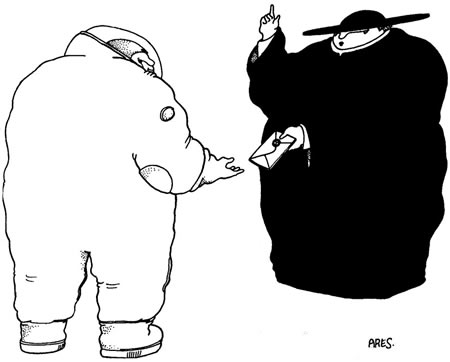
(1987) Premiado en Cuba y Colombia.
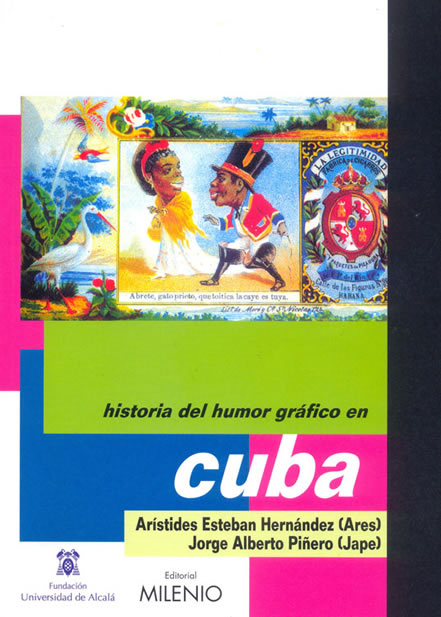
Historia del humor gráfico en Cuba. Libro realizado en coautoría con Jape,
publicado por Editorial Milenio de España
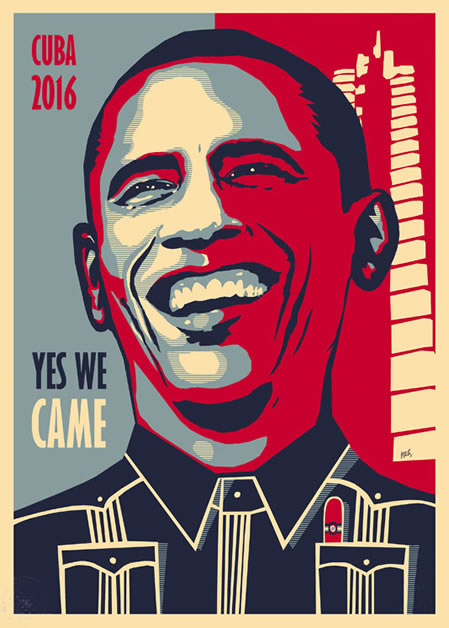
2016) Cartel serigráfico realizado con motivo de la visita de Obama a Cuba.
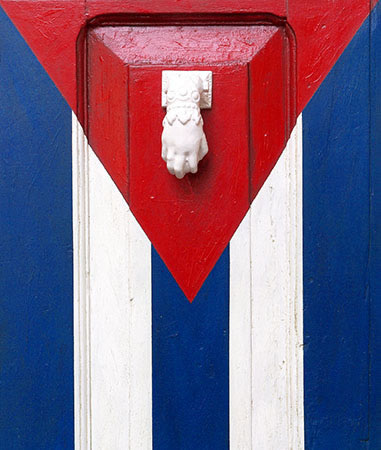
(2016) Cuba, Acrílico y metal sobre madera.
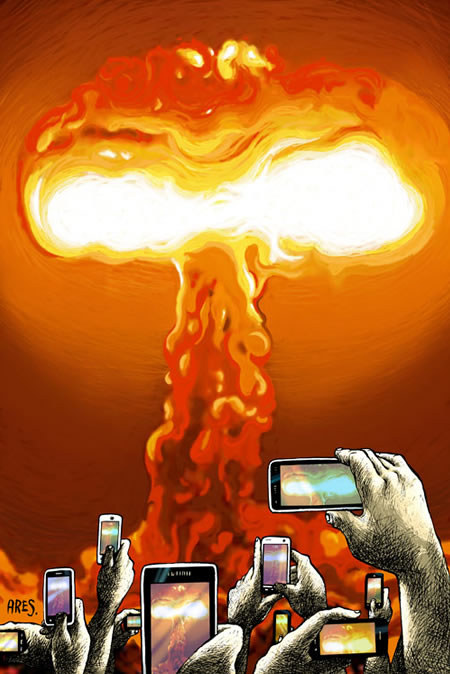
(2015) Premiado en Cuba.
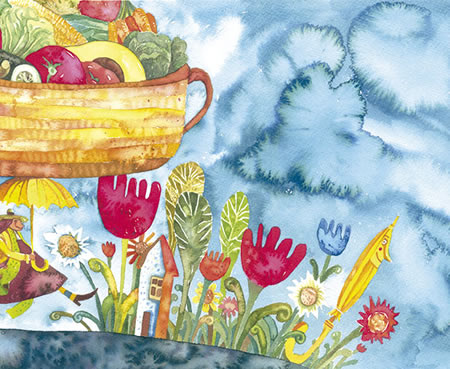
Ilustraciones para el libro infantil "Vuelve la sombrilla amarilla"
de la autora Ivette Vian".
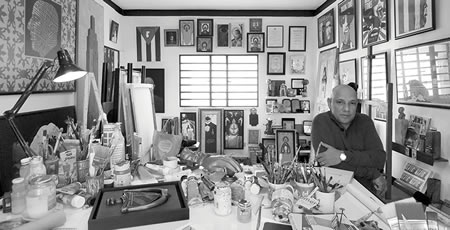
Ares en su estudio.
Interview with Ares
By Pepe Pelayo
A superhyperultramega-awarded comedian
Regarding Cuban graphic humor, I can say that as a child I always enjoyed the cartoons that were published in the back pages of Bohemia magazine and I grew up with "Zig Zag", "El Pitirre", "Palante", "El sable", " La Chicharra", "Dedeté" and "Melaíto". And I saw caricatures of Landaluze, Horacio, Prohías, Frémez, Guerrero, Muñoz Bachs, Sergio, Abela, Raúl de la Nuez, René de la Nuez, Adigio, Fornés, Chago, Fresquito Fresquet, Val, Pitín, Betan, Miriam, Évora Tamayo , Cardi, Delga, Wilson, Ñico, José Luis, Betanzos, Felo, Pecruz, Mitjans, Rosen, Alexis, Lillo, Pime, Milan, Lloró, Chevo, De Armas, Alba, Perfecto Romero, Blanquito, Arístides, Behemaras, Posada, Chamaco, Ardíon, Virgilio, Urra, Jerez, Carlucho, Manuel, Ajubel, Juan Padrón, Tomy, Torres, Hernán Hernández, Tonel, René, Pedro Méndez, Douglas Nelson, Martirena, Roland, Panchito, Polo, Linares, Delga, Felix, Janier, Lázaro, Laz, Boligan, Simanca, Carrillo, Lauzán, Tamayo, Abela (grandson), Acebo, Agramonte, Castillo, Avilés, Emilio, Grant, Guille, Lumat, Migue, O. Tejedor, Peroga, Quiala, Quintana, Romero Pino, Testón, Tomaso, Urguellés, Ramsés, Adán, Omar Santana, Osval, Lacoste, Roger, Garrincha, Villamil, Falco, Bermúdez, Toledo, Jánler, Zardolla, Orlandito, Joseph and other colleagues that I will surely forget, since I am appealing to the memory and research of my interviewee. Therefore, I apologize for any omissions. But I didn't make this list for pleasure. It was to give me the opportunity to pay tribute to all the Cuban cartoonists (whether they are on this list or not), for offering me so much enjoyment with their works and for helping me with my training. Thank you a thousand.
Well, from the best of the best of Cuban graphic humor, I selected one that I did not name previously on purpose. I have the honor and pleasure (and they are not protocol words in this case) to develop this dialogue with the award-winning Cuban caricaturist, illustrator, painter and psychiatrist, my good friend Arístides Esteban Hernández Guerrero, known worldwide as “Ares”, because that is how he signs his work.
PP: What differentiates the Ares from the beginning to the one now? I am not referring to the experience acquired, to maturity; but whether you had changes in concepts in humor, both in form and content.
ARES: Many things differentiate me from that Ares of the beginnings and I consider that a fortune, if I continued doing the same thing that I conceived thirty-five years ago I would be liquidated. When I started, and after some experimentation, I think I found a personal way of drawing humor quite quickly. That beginning is marked by a joke focused on the gag that evaded the text and by a fairly clean, somewhat naive figuration with characters that I would define as good-natured who evolved in a couple of years towards those fat people who marked my aesthetic.
As a result of a habitual process that has been occurring in me for years, my humor changed from the candid to the acidic and the figuration of my characters moved to the grotesque as an inevitable consequence of the transformation in the contents, which I consider more attentive to the time and the world around me.
Another aspect of the differences between those Ares has been the dissolution of the border that delimited my graphic humor, which is evident in the diversification of the artistic expressions in which I move and the techniques I use in them. If at the beginning I only made caricatures with ink on cardboard, now, without ever abandoning this technique, I also use watercolor, acrylic on cardboard, canvas or wood, screen printing, digital techniques and I do the same illustrations for books, posters, painting , murals, sculptures, installations….
But it seems to me that despite all these changes, the conceptual matrix of all my work was already evident from my first works. Now I have less hair and more belly, I look different but I am still the same.
PP: In addition to being such an award-winning creator of graphic humor as I rightly pointed out in the title of this dialogue, I know that you are interested in the history of the genre in Cuba and you even dedicate time to rescuing and promoting new values. And on top of that, you open exhibitions and serve as a jury all over the world. How do you manage to fulfill all that, while still being a family and social being?
ARES: I don't have specific hours or space to work. Some colleagues of mine start creating at eight in the morning and the family does not bother them until they finish, I assure you that is not my case. There are days when I don't have a minute to make works, on other occasions I spend creation days of sixteen or more hours a day without stopping for one or several months. My wife also says that my insomnia is the most productive she knows.
When I can't concentrate on drawing or painting I start writing and organizing the texts and images that later become my books. While I am in meetings I draw non-stop and I even use those images in exhibitions, when I am not creating I continue living and the origin of my ideas is in my life.
I am used to creating against time and under any circumstances. I began to publish drawings when I was twenty years old and a third-year medical student. Remember that for fifteen years I combined my creation with my studies at the university, my social service in the mountains of Guantánamo, the direction of a rural hospital, childbirth, consultations, medical guards, studies of my specialization in psychiatry, medical research, my work as a psychiatrist at the Calixto García Hospital and at the Combinado del Este (the largest penitentiary center in Cuba).
My work, my social and personal life are just parts of a unique something, which is me. They are intertwined on all sides and that is something that I suffer and enjoy. My family is the creator of many of my creations, I also enjoy openings, concerts and more activities with them that are part of our social life and my creative life. My friends, fans, students and many other people circulate around the house in endless traffic, parties and joint activities are a space for fun but also for new projects. And from what you say about young values, I only help and promote those who I believe are talented, those in turn become part of my group of friends, which is why it is true that I am always giving, but I am also always receiving.
PP: Both in your line, your style, and in your content, do you think you have a defined, clear influence from living or historical Cuban colleagues?
ARES: Yes, I have influence from many people, which I don't know if it is clear or defined. Nothing is born from nothing and when we all begin we look for canons that help us direct our path, whether in the structuring of our personality or in our training as artists, which is a fundamental part of our individuality.
As a boy and before publishing any drawings, he mimetically copied caricatures published in Palante, Dedeté, Bohemia... into school notebooks, as well as the comics of the character “Naoh” that Roberto Alfonso drew. I also invented naive imitations of American comics, like Dick Tracy, and I drew characters from the samurai, cowboy, and war movies that I watched with my father; He created characters, made caricatures of colleagues and teachers. I also remember having visited a small exhibition of Picasso in Fine Arts and I do not forget that that contact shook my spirit.
When I started seriously with graphic humor, what interested me most about what existed in Cuba at that time was the aesthetics of Dedeté. That first path drew on Carlucho, Manuel, Tomy, Ajubel... Some colleagues and critics considered, due to my plump characters, that I had influences from the Colombian painter Botero. In that specific case I tell you that this is not the case, I was twenty years old and did not know his work at that time because, being self-taught, I was completely unaware of many expressions and artists of Cuban and universal art.
Then, participating in international events made me discover other ways and I felt inclined towards some lines of graphic humor that were reproduced in the catalogues. It is quite difficult for me to list all the names that have marked me in some way, there are many, but I can tell you that my influences have not been restricted to humorous drawing but also cover other areas of the visual arts.
PP: Graphic comedians make personal, editorial or traditional caricatures, etc., because their intention is to make people laugh or smile, although some – like you – also combine that intention with thinking, but without ceasing to provoke it with humor. no matter how conceptual the idea is, because otherwise they would not be “graphic comedians.” Do you agree with that?
ARES: I agree with you. I say that my humor is essentially serious, conceptual perhaps... but that is a general definition. I have many works that can cause a lot of laughter and even laughter. Humor is in all the things I do, but it is primarily within me, I cannot avoid making comments or associations that generate laughter in any space, that defines me as a person and that is the basis of all the work I do.
When doing my work as a graphic comedian, I work with surprise and use the image as a mediator. I think that the conceptual is given because I look for in all the visual and content information that circulates within me the way to make associations in which the points of origin of the elements that make them up are distant and paradoxical, the close links are more common, they occur to anyone and I think that in that process of having information, searching for it and finding the gear in your consciousness is where the crux of the thing is.
I don't even know if I answered your question, although I know that it is inevitable in this exchange with another comedian not to end up theorizing about the topic, now... for me it is always easier to say what something is NOT humor than to define why something else IS.
PP: Fashionable question: are there limits to humor?
ARES: Do you put yourself in the situation of the editor of a publication...? Already? So... Do you make or agree to publish drawings extolling the superiority of one race over another? Do you make or agree to publish jokes in favor of pedophilia?
It turns out, as I see, that no artist accepts having limits and that certainly makes me laugh in the position of spectator. The cartoonists who play on the board with the white pieces make many jokes about the black pieces, those who are on the side of the black king make jokes about the white pieces, those who make jokes about the two are considered gray but you will never see them mess with the owners of the board. We all live with some form of censorship, be it political, religious, economic, ideological... The limits for humor exist, as for everything, my brother, but the ones that interest me are those that are intertwined with the ethics of the cartoonist.
Carlos Saura's filmography comes to mind; without the limits imposed by Franco's regime, his films would have been different. Many of the best works of art I have seen have arisen in that debate between limits, censorship, symbols and the ability of the creator to say and address everything with mastery.
I also believe that it is impossible to be impartial but if it is necessary to be honest with yourself and above any limit make a work that responds to your artistic and ethical convictions, that is what I have tried to do in these thirty-five years of career. .
There is a detail that I want to refer to that I don't know if it is within the limit of your question but it is associated with it: We caricaturists give ourselves more importance than we have, many of us believe that with one drawing or with many we can change the order of the images. things and that is a lie.
Humor points out things, influences opinions, but it does not have that power that we attribute to it. If that were the case, I assure you that the world would have been a better place a long time ago. That force that we intend is dispersed in other segments of contemporary society, we are a team with a small body and a very large Ego.
PP: Do you feel happy and fulfilled with your career in comedy, with so many awards? How does it feel to know that you are one of the greatest Cuban cartoonists of all time? (I know you and I know that you are not arrogant or self-sufficient, but don't be very modest now either, please.)
ARES: I am a man who works on something that fascinates him and who also makes a living from that work. That is something that gives me a lot of well-being and that I have always transmitted to my daughters: discover what they like and try to do everything in your power to work on it, because when that happens no matter what happens you will be a happy person.
Fully realized? That would be asking too much, I always live with a spirit of nonconformity when it comes to my work. This generates a habitual anxiety in me, it makes me very critical of myself, of what I do and forces me to always be looking for something new.
PP: To finish, in one sentence, can you send a message to these people?:
1- The new Cuban caricaturists.
ARES: Work and do good things, competing with you makes me grow.
2- Colleagues who might envy you.
ARES: Keep envying, that forces me to conceive good things to give you new reasons.
3- The simple consumers of your art who admire you and follow you in Cuba and the world, like me.
ARES: A work without receptors is like a suicidal sperm. I thank the consumers of my art for that fruitful complicity.
4- To me.
ARES: Don't grow old. Don't complain about what you didn't do... do it. Don't lose the ability to admire. Learn from mistakes. Don't look, observe. Live, that's where the inspiration is. Don't focus only on comedians, look in other spaces of creation for reasons for your humor. Take care of yourself so that you live many years that you are loved... And don't bother me anymore by asking for interviews!
PP: I'm sorry. Friendship has its price, so I'm going to screw you, ha ha. Seriously, I thank you from the bottom of my heart for stealing your precious and scarce time. A hug brother.
(This text has been translated into English by Google Translate)

